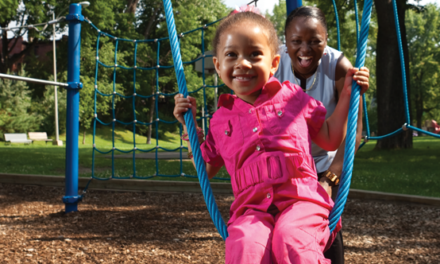For many Americans, the COVID-19 pandemic has brought to light the large number of essential, nonacademic functions of schools, but will our accountability systems take note?
The COVID-19 pandemic has led many of us to reconsider what we deem to be the nation’s most essential institutions. Our hospitals and grocery stores, for instance, have never seemed so important. And in the same vein, our public schools have been showered with newfound appreciation. News programs and social media have been full of praise for teachers — not just for the academic instruction they provide, but also for being a stable and caring presence in students’ lives. Americans have also come to recognize the many vital social services schools offer, including mental health care, occupational and physical therapy, and the delivery of regular meals for low-income students. Take those services away, and even the fiercest critics of public education begin to see their schools in a new light, coming to understand just how varied are the ways in which children, parents, and communities rely on them.
State governments, however, have yet to open their eyes. They may have waived standardized testing this year (Strauss, 2020), but once their public schools reopen, they’ll go right back to measuring them by the same few metrics they’ve used for more than a generation: test scores in reading and math, high school graduation rates, and, in some cases, student attendance (Ladd & Loeb, 2013).
Critics have long highlighted the shortcomings of this approach to school accountability (Schneider, 2017), but never has it looked so out-of-step with the actual work of educating children. As so many Americans have come to appreciate, schools pursue a broad range of aims: not just to teach academic content but also to cultivate social skills and critical thinking, prepare young people for work and citizenship, foster creativity, and promote emotional and physical health (Wilder, Jacobsen, & Rothstein, 2008). Those of us who are suddenly educating our children at home have become keenly aware of the complex and multifaceted nature of this work.
The turn toward educating children at home also makes the resource gaps between families all the more evident. More affluent parents are more likely to own musical instruments, art supplies, computers, an internet router, and a car (with which to drive their children to parks and hiking trails, if open). However, most families depend on their local schools to provide their children with such a rich and varied curriculum, and they have been hard-pressed to make up the difference. For them, reducing schools to basic online instruction in math and English is tragic; yet that is essentially what present accountability systems encourage.
For decades, education researchers have known that standardized test scores, which carry the most weight in accountability formulas, tend to correlate strongly with student background variables like family income and parents’ college completion rates (Tienken, 2017). In other words, they tell us more about out-of-school factors — what students bring to school — than about the performance of schools themselves. That’s part of the reason why states, under ESSA, have tweaked their accountability systems.
But measuring schools more broadly is not enough. We also need to change the ways in which accountability determinations are made. At present, accountability scores are calculated via algorithm (metrics in, ratings out) — a mechanical process that leaves no room for human judgment and deliberation about each school’s strengths and weaknesses, or the particular challenges it faces.
There are certain things all schools must do well — provide effective reading instruction, maintain a safe and orderly learning environment, and so on — but our best schools also respond in thoughtful ways to local needs and contexts. In rural areas, for example, public schools often provide a hub for community life. In urban areas with high levels of student diversity, they may prioritize English language instruction and culturally responsive pedagogy. Some schools choose to emphasize projects and student-directed learning. Others opt to focus on character education. These differences matter, but they are invisible to the number crunching that characterizes present accountability systems.
Schools are highly complex organizations, and determining their true quality requires the sort of careful, holistic, human judgment that our society has always relied upon to make consequential decisions in politics, the law, and other arenas. Consider how jury trials function. Every case requires a group of ordinary citizens to examine the particular facts at hand, weigh competing arguments, and render judgment by way of thorough deliberation. Applied to public education, such a model would do much to remedy the flaws in existing accountability systems.
Educating young people involves far more than getting them into their seats and raising their scores.
A deliberative process of educational accountability would ensure not only that relevant aspects of a school’s work — the particular challenges it faces, its resources, and the goals it has chosen to pursue — are taken into account, but also that they are weighed appropriately. This kind of approach would do justice to schools, attending to goals and practices that proponents of test-based accountability often write off as “hard to measure.” Further, it would take into account whatever a given school happens to have faced in that particular year, whether it be a worldwide pandemic, a hurricane, or some other crisis.
Educating young people involves far more than getting them into their seats and raising their scores. We expect our schools to motivate students, care for them, and keep them safe. Schools introduce young people to the wider world, help them discover their talents and their interests, and alter their life trajectories. Of course, teaching academic skills that can be measured via standardized tests is important, but that can’t be all that matters. We owe it to our teachers, our students, and ourselves to align our accountability systems with our true values.
Can all of the work of our public education system be measured? Perhaps not with perfect precision. But we can certainly assess it in more sensible ways than we have until now. At the moment, we have far bigger problems to tackle. But when the time comes to reconsider the ways in which we evaluate our schools, we shouldn’t forget what the pandemic has revealed to so many of us: We haven’t been giving public education the credit it deserves.
Note: Order of authorship was determined by coin flip.
References
Ladd, H. & Loeb, S. (2013). The challenges of measuring school quality: Implications for educational equity. In D. Allen & R. Reich (Eds.), Education, Justice, and Democracy (pp. 22-55). Chicago, IL: University of Chicago Press.
Schneider, J. (2017, October 23). What makes a great school? Usable Knowledge.
Strauss, V. (2020, March 20). Trump administration is waiving all federal requirements for standardized testing in public schools. The Washington Post.
Tienken, C. (2017, July 5). Students’ test scores tell us more about the community they live in than what they know. The Conversation.
Wilder, T., Jacobsen, R., & Rothstein, R. (2008). Grading education: Getting accountability right. Washington, DC: Economic Policy Institute.
ABOUT THE AUTHORS

Derek Gottlieb
Derek Gottlieb is an assistant professor at the University of Northern Colorado in Greeley. He is the author of A Democratic Theory of Educational Accountability: From Test-Based Assessment to Interpersonal Responsibility.

Jack Schneider
Jack Schneider is an associate professor of education at the University of Massachusetts, Lowell; co-founder of the Massachusetts Consortium for Innovative Education Assessment; and the director of the Education Commonwealth Project. He is the author of A Wolf at the Schoolhouse Door: The Dismantling of Public Education and the Future of School.










